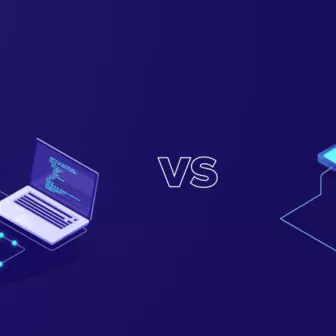Completely cultured DevOps practices are required for the successful implementations of cloud-natives. There has been seen in change functionalities and liabilities as the infrastructure is moving into the cloud. Consequently, the interaction between developers and operations teams has been refurbished to some extent and is still ongoing, shifting the definition of DevOps to a whole new level.

The evolution of cloud-native technologies, DevOps will also evolve to cater to the requirements of different forms of workloads. New techniques, immensely developed open-source communities will streamline the workflow. With continuous improvements, feedback, continuous testing, delivery and management and monitoring of services across a distributed environment will ascertain the pace of automation.
Let us dig deep to understand how the continuous evolution in DevOps practices will affect the complete development cycle, at the very first starting with a quick glance on DevOps.
What is DevOps?
The distinct cultural ideologies, tools, practices when brought together enhances the capability of an organization focused to deliver upscaled services and applications to the end-users or clients. Additionally keeping the speed of the development rapid with continuous integration and delivery highlighting the organization's service in the competitive market. The diagram below gives an overview of the DevOps.

As we can see in a DevOps culture, Development and Operations teams work in association with each other in a continuous delivery pipeline and feedback loop to deliver the service best in the industry. In addition to this, in few DevOps models, during the complete application lifecycle, the QA and security teams are tightly coupled with the development and operations, customarily referred to as DevSecOps.
DevOps with Cloud Native “A Perfect Pair”
Cloud-native is beyond cloud-only. Be it in the cloud or on-premises it leads the software and IT with the best cloud-centric practices — Jason Bloomberg
Cloud-native DevOps are the set of fundamentals flourishing lately in the DevOps tools community centralized towards the build, deployment, and management of applications and services in a cloud-native perspective. Many get confused with the terms ‘cloud-native’ and ‘cloud-only’. They presume cloud-native means on the cloud, which is quite misleading. Jason Bloomberg, President at Intellyx states that, whether in cloud or on-prem, the key cloud practices that are brought to the software and IT forefront.
Containers, microservices, Kubernetes lie at the heart of the cloud-native principle. The former mentioned have changed the complete application building landscape. Development, deployment, and management of extensive applications is done with the help of containers, used as the process elements in a cloud-native approach. Cloud-native DevOps is, therefore, has been regarded as an approach that strengthens the current requirements for developers and IT teams establishing technology stipulated workflows to maximize the core business objectives.
The Cloud Native Computing Foundation (CNCF) defines it as an ideology with a “pan-cloud” approach following service level agreement (SLA) which allows internetworking, needed to build, run broader scale applications on public, private and hybrid cloud environments. Tools like containers, service meshes, microservices, invariable infrastructure, and declarative APIs symbolize cloud-natives. Consequently, cloud-native DevOps are propounded as the applications that are built, tested and are arranged with the cloud tools base in a public cloud environment.
Adding further, cloud-native DevOps is applicable for both on-premises applications and the applications that are based on the cloud. Also, similar to cloud-native a single DevOps template can’t be considered for the whole application building process. Cloud-native DevOps brings automation, paced up iterations with on-time delivery of the software by keeping the IT operations and development team tightly coupled and also scaling up the efficiency of an organization with infrastructure abstraction, redefined workflows, better monitoring through observability and tooling.
Culture Change with DevOps
With the streamlined support from the DevOps, continuous integration and continuous delivery, the distribution of software has been paced up with microservices in the cloud-native environments. The very first thing that is imperative for the former mentioned is to embrace the DevOps culture.
The complete shift from the old to the new paradigm is not very much easy to handle as it redefines the old tools and processes to an entirely new level. This bridges the gap between all the stakeholders within the organization encompassing businesses, operations, developers and other teams. The former mentioned are very much essential to build and maintain cloud-native applications.
Shifting Devops to Cloud-Native “The Issues”
- The Cloud Native and Development Association: When operationalized, DevOps does the automation of all the applications associated with the development and operations divisions. Splitting processes into cloud-native and not-so-cloud natives ones will bring silos in the organization, doing no good for the organization as a whole. Instead, it may work when the complete development gets shifted to cloud-native. But, restricting organization to a single platform is exactly opposite from a DevOps guideline.
- Staged Pipelines: The very basic definition of DevOps states the complete management is handled by the operations teams. Shifting DevOps to the cloud will separate the teams that are in charge of automation process management inside an organization. Consequently, it sends a wrong signal to the people of not entrusting the automation toolchain and management for their businesses.
- Fulfilling ‘All’ Cloud Native Objectives: Organizations don't believe in enforcing every component into the public cloud including the cloud-native apps. As their apps are hosted on platforms like GKE(Google Kubernetes Engine), PKS(Pivotal Container Service) and AKS(Azure Kubernetes Service), the databases, data stores, and streams moved back to the on-premise infrastructure. This propounds the situation of a security breach and may lead an organization to a new uncalled risk.
- Enabling paced DevOps Growth ‘Deception’: A single DevOps template for all is a misnomer when moving forward with a DevOps approach. In order to bring more growth and efficiency to the organization, it is imperative to form all-exclusive automated chains, pipelines for the perfect delivery and enhanced performance. It has been seen that organizations that start with DevOps instantly face failures instantly.
Shifting DevOps to Cloud-Native “The Approach to Follow”
As it has been known, Communication is the key for DevOps. Clear stated communication is vital along with the process automation as with the feedback loops the changes traverse fast across the DevOps pipeline. In addition to that communication with tooling will magnify the DevOps process and also bringing benefits for both business and end-users.
Cloud Foundry, Kubernetes are the few tools enhancing the experience for the developers making it more foreseeable and expandable.
- Business Team Assistance: In order to create an efficient feedback cycle between customers and development teams, the involvement of the business aspect is essential. The IT department will initiate the shift of DevOps from on-prem infrastructure to microservices, running on a cloud-native platform. But with no involvement from the business team vertical will keep everything neutral. Brian Dawson, a DevOps evangelist at CloudBees states, Involvement of business is a prerequisite when shifting DevOps to a cloud-native world.
- Roles In CI/CD Pipeline: As stated at the beginning of this article with the complete paradigm shift with the redefining of DevOps to cloud-native the roles and responsibilities of the team members get revived. In order to create the development process smooth, in cloud-native DevOps, more freedom is given to the developers and engineers. This streamlines the work for the development teams resulting in building their own servers.
Promises to be made for successful Cloud-Native & DevOps integration
To cater to efficient cloud-native DevOps integration, companies should undertake the following three :
Transparency
Transparency is vital for an effective decision-making process inside the organization. Having an open platform implies the smooth decision-making process along with the sharing of both favorable and unfavorable results. Additionally, any bottlenecks, mistakes, and low-points in the systems can be discussed freely slacking the position or level of experience inside the organization. This, in turn, will help in building a healthy working organization.
Liberty
To ensure the proper functioning of a DevOps organization, it is indispensable to have a clear understanding of the business by the engineers and developers. The engineering and technical teams should understand the requirements stated by the customers, stakeholders. Hereafter comes up with the solutions for the problems or requirements stated by the client, partners with complete freedom.
Automation
In order to have smooth changes in the code release process, the automation has to be intact and efficient. It consists of infrastructure as code (IaC), continuous integration and test automation which are being used in every stage of development, including the production.
Conclusion
The organizations approaching the cloud-native DevOps should the very first move from the monolithic deployment practices and platforms to the cloud-based deployment methodology. Moving ahead with transparency, anatomy, and automation the teams inside the organizations will achieve more. Along with that the IT managers and DevOps lead should always be working on searching for the best tools for the DevOps eventually scaling up the process.
Subscribe
Related Blogs
Serverless vs Managed Services: Which One to Choose

When you decide to build an application in the cloud, you need to consider several factors. One of the most important…

Over the past few years, the cloud industry has gone through an extreme change with the transformation of serverless…
Putting The Serverless Trend Under a Microscope

Flexible. Scalable. Economical. These terms essentially sum up the advantages of serverless computing, an architecture that…




